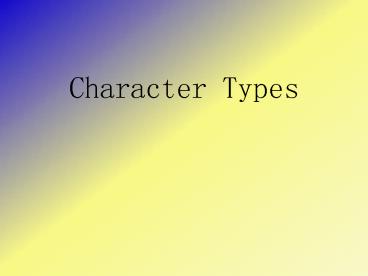Character Types - PowerPoint PPT Presentation
1 / 18
Title:
Character Types
Description:
Character Types 7 Common Character Types Flat Round Dynamic Static Stock Foil Confidante Round or Flat? Authors must decide how much detail to include about each ... – PowerPoint PPT presentation
Number of Views:806
Avg rating:3.0/5.0
Title: Character Types
1
Character Types
2
7 Common Character Types
- Flat
- Round
- Dynamic
- Static
- Stock
- Foil
- Confidante
3
Round or Flat?
- Authors must decide how much detail to include
about each character. - Which characters are most important?
- How will giving detail, or not giving detail,
about that character affect the story?
4
Round
- Characters that are described in depth, with many
details, are well-rounded characters. They are
called round characters. - The main character in a story is almost always
round. - If you are reading a story and you feel like you
know a character extremely well, then most likely
the character is round.
5
Flat
- Characters that are not described well that you
are not given much information about are flat
characters.
6
Flat
- Consider a drawing a three- dimensional drawing
gives more detail than a one-dimensional drawing.
- If you draw a two-dimensional, flat picture of a
house, for example, you can only see one side of
it. You cannot see three of the four sides. - This is how a flat character is you can only see
a few characteristics of the character. There are
many things you cannot see, or many details you
are not given by the author.
Round
7
Round or Flat?
- As a reader, judge whether or not the character
is round or flat by trying to write down
characteristics of the character. - Answer the question What do you know about the
character? If your list is long, with many
characteristics, then the character is round. If
your list is short, or there are not many
characteristics at all, then the character is
flat.
8
Static or Dynamic?
9
Static or Dynamic?
- The key word when dealing with the difference
between static and dynamic characters is
change. - The type of change, though, is specific. We are
only concerned with internal changes changes
which occur within the character. - Internal changes include a change in his/her
personality , a change in his/her outlook on
life, a change in his/her values, or it could be
an overall change in the nature of the character.
10
Static or Dynamic?
- Do not focus on changes that happen TO a
character, but rather, changes that happen WITHIN
a character. - Think about it this way Does the event affect
the character by changing the character
internally?
11
Static
- Static not moving or changing
- (ex static electricity is static unlike current
electricity which is moving!! - In order for a character to be considered a
static character, the character must remain
basically the same throughout the entire story. - The character does not undergo any internal
changes.
12
Static
- Think of static characterization like plastic
surgery. The character may change in looks, but
unless his/her personality is affected, the
character is static.
13
Dynamic
- A dynamic character is a character that undergoes
an internal change sometime between the beginning
and end of the story. - The change in the character is usually crucial to
the story itself.
14
Dynamic
- Say a main character goes through a life-altering
experience, such as a race car driver getting
into an accident. If the driver's personality
changes, and he is no longer willing to take on
the risk of driving a race car, the character
would be dynamic.
15
Static or Dynamic?
- Look closely at your character at the beginning
of the story. Ask these three questions - How does the character feel about him/her/itself?
- How does the character act towards others?
- What is the characters goal?
- Examine your character throughout the story and
at the end of the story. Have the answers to the
questions changed? - Static no change within the character
- Dynamic the character changes internally
16
Stock Character
- A stock character is
- special kind of flat character who is instantly
recognizable to most readers. - They are stock or typecast or stereotypical
characters - Examples include the ruthless businessman
- the shushing old, white-haired librarian
- the dumb jock
- They are not focus characters nor are they
developed in the story. - (They fulfill background or filler roles.)
17
Foil Character
- A foil character is
- special kind of character who is used to enhance
another character through contrast - i.e. as opposites they highlight qualities of a
central character - Examples include
- - the mean step-sisters contrast to
Cinderellas character - - Ashers silly, careless, childish qualities
contrast and highlight some of Jonas
qualities. - They are not focus characters nor are they
developed in the story. - (They help us learn more about another
character or aspect of a story.)
18
Confidante Character
- A confidant character is
- special kind of character who the main character
confides in. - When the main character confides (shares/trusts)
they reveal qualities, personality, thoughts,
feelings - Example
- - Gabriel is a confident for Jonas to share some
of his feelings with (although Gabe serves other
purposes as well) - A confidante helps us learn more about our
central/main character






























